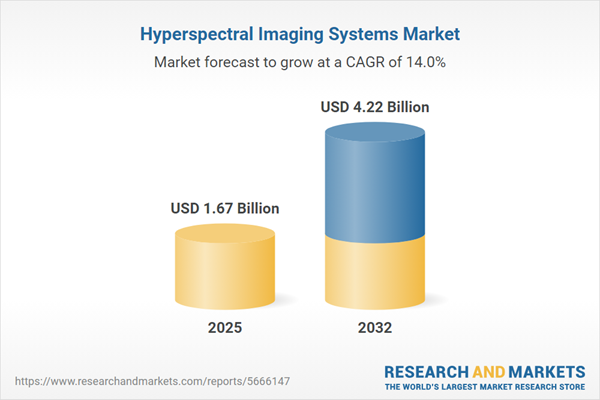Speak directly to the analyst to clarify any post sales queries you may have.
Hyperspectral imaging systems are redefining data capture and analysis for organizations that require exceptional precision and real-time insights. As industries adopt advanced imaging methods to address complex operational challenges, senior leaders must navigate a rapidly changing technology and regulatory landscape to convert emerging opportunities into measurable business outcomes.
Market Snapshot: Hyperspectral Imaging Systems Market Insights
The Hyperspectral Imaging Systems Market grew from USD 1.47 billion in 2024 to USD 1.67 billion in 2025. It is expected to continue growing at a CAGR of 14.04%, reaching USD 4.22 billion by 2032. This upward trajectory is supported by widespread adoption in sectors such as agriculture, defense, environmental monitoring, and pharmaceuticals, reflecting the rising demand for advanced data analytics, miniaturized sensors, and robust real-time processing. The primary keyword, "hyperspectral imaging systems market," is relevant for leaders seeking insight into growth drivers shaping this specialized segment.
Scope & Segmentation: Key Dimensions Shaping the Hyperspectral Imaging Systems Market
This report delivers in-depth analysis across the full hyperspectral imaging value chain, with structured coverage of the following areas:
- Product Type: Hardware, Software
- Technology: Push Broom, Snapshot, Spatiospectral Scanning, Whisk Broom
- Spectral Range: Longwave Infrared, Midwave Infrared, Shortwave Infrared, Visible-Near Infrared
- Application: Defense & Security, Environmental Monitoring, Food Quality & Safety, Infrastructure Inspection, Mining & Prospecting, Pharmaceuticals & Biomedical Research, Precision Agriculture, Research & Development
- Region: Americas, including North America (United States, Canada, Mexico) and Latin America (Brazil, Argentina, Chile, Colombia, Peru); Europe, Middle East & Africa, spanning Europe (United Kingdom, Germany, France, Russia, Italy, Spain, Netherlands, Sweden, Poland, Switzerland), Middle East (United Arab Emirates, Saudi Arabia, Qatar, Turkey, Israel), and Africa (South Africa, Nigeria, Egypt, Kenya); Asia-Pacific, covering China, India, Japan, Australia, South Korea, Indonesia, Thailand, Malaysia, Singapore, Taiwan
- Notable Companies: Analytik Ltd., Applied Spectral Imaging, BaySpec Inc., Brandywine Photonics LLC, Carl Zeiss AG, Clyde HyperSpectral Imaging and Technology Ltd., Corning Incorporated, Cubert GmbH, CytoViva Inc., Exosens, Gamaya, Headwall Photonics Inc., Horiba Ltd., IMEC Inc., LLA Instruments GmbH, Middleton Spectral Vision, Norsk Elektro Optikk AS, Northrop Grumman Corporation, Photon Etc. Inc., Pixxel Space Technologies Inc., Resonon Inc., Specim (by Konica Minolta), Surface Optics Corporation, Teledyne Technologies Incorporated, XIMEA GmbH
Key Takeaways for Executive Decision-Makers
- Next-generation miniaturized sensors and advanced on-board processing are expanding hyperspectral imaging applications into portable and unmanned systems, driving wider field use and real-time analysis capabilities.
- Integration with complementary technologies such as LiDAR and multispectral cameras enables holistic scene interpretation, supporting more actionable insights in challenging environments across target industries.
- Open-source software and standardized data formats are accelerating development of sector-specific toolchains, reducing time-to-market for new analytics solutions and supporting collaborative innovation among stakeholders.
- Regional market dynamics mandate tailored go-to-market strategies, with localized production, regulatory compliance, and investment priorities shaping both product development and deployment success.
- Strategic partnerships among research institutions, system integrators, and solution providers are critical in advancing both technological performance and scalable business models.
Tariff Impact: Navigating Cost Pressures and Supply Chain Adjustments
Recent U.S. tariff measures have increased costs for essential optical and electronic components, prompting manufacturers and integrators to reassess their supply chain strategies. This shift accelerates sourcing diversification and drives the adoption of modular system architectures to ensure operational resilience and maintain competitive differentiation. Decision-makers must account for these factors when evaluating partnerships and investment timing.
Methodology & Data Sources
The analysis combines qualitative interviews with sector leaders and technical experts, thorough quantitative data review of deployments and component trends, and cross-validation with third-party statistics, patents, and technical documents. This approach supports robust identification of market inflection points and reliable scenario outcomes.
Why This Report Matters
- Enables leaders to identify emerging high-value applications and optimize resource allocation in line with sectoral adoption rates.
- Provides actionable recommendations on technology investment, supply chain strategy, and go-to-market approaches tailored by region and vertical.
- Equips teams to benchmark competitive offerings, collaborate across the ecosystem, and reduce risk in the face of rapid technological change.
Conclusion
This report delivers granular, actionable insights crucial for leadership-level decisions in the hyperspectral imaging systems market. Leveraging these findings will help drive innovation, strengthen competitiveness, and ensure informed strategic planning.
Additional Product Information:
- Purchase of this report includes 1 year online access with quarterly updates.
- This report can be updated on request. Please contact our Customer Experience team using the Ask a Question widget on our website.
Table of Contents
3. Executive Summary
4. Market Overview
7. Cumulative Impact of Artificial Intelligence 2025
Companies Mentioned
The companies profiled in this Hyperspectral Imaging Systems market report include:- Analytik Ltd.
- Applied Spectral Imaging
- BaySpec, Inc.
- Brandywine Photonics, LLC
- Carl Zeiss AG
- Clyde HyperSpectral Imaging and Technology Ltd.
- Corning Incorporated
- Cubert GmbH
- CytoViva, Inc.
- Exosens
- Gamaya
- Headwall Photonics, Inc.
- Horiba, Ltd.
- IMEC Inc.
- LLA Instruments GmbH
- Middleton Spectral Vision
- Norsk Elektro Optikk AS
- Northrop Grumman Corporation
- Photon Etc. Inc.
- Pixxel Space Technologies, Inc.
- Resonon Inc.
- Specim, Spectral Imaging Ltd. by Konica Minolta Business Solutions Europe GmbH
- Surface Optics Corporation
- Teledyne Technologies Incorporated
- XIMEA GmbH
Table Information
| Report Attribute | Details |
|---|---|
| No. of Pages | 180 |
| Published | November 2025 |
| Forecast Period | 2025 - 2032 |
| Estimated Market Value ( USD | $ 1.67 Billion |
| Forecasted Market Value ( USD | $ 4.22 Billion |
| Compound Annual Growth Rate | 14.0% |
| Regions Covered | Global |
| No. of Companies Mentioned | 26 |









